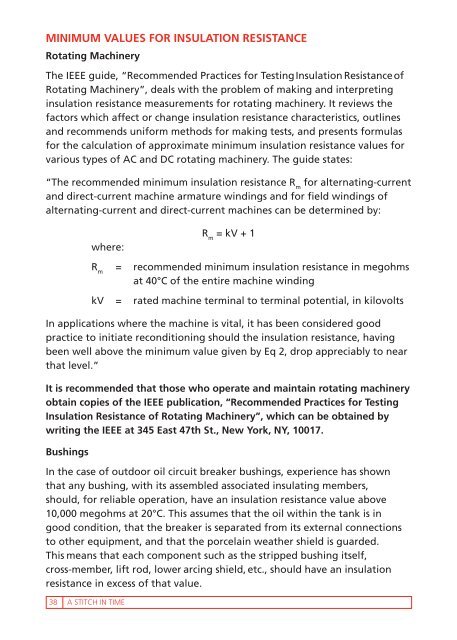“A Stitch in Time...”
You also want an ePaper? Increase the reach of your titles
YUMPU automatically turns print PDFs into web optimized ePapers that Google loves.
M<strong>in</strong>imum Values for Insulation Resistance<br />
Rotat<strong>in</strong>g Mach<strong>in</strong>ery<br />
The IEEE guide, “Recommended Practices for Test<strong>in</strong>g Insulation Resistance of<br />
Rotat<strong>in</strong>g Mach<strong>in</strong>ery<strong>”</strong>, deals with the problem of mak<strong>in</strong>g and <strong>in</strong>terpret<strong>in</strong>g<br />
<strong>in</strong>sulation resistance measurements for rotat<strong>in</strong>g mach<strong>in</strong>ery. It reviews the<br />
factors which affect or change <strong>in</strong>sulation resistance characteristics, outl<strong>in</strong>es<br />
and recommends uniform methods for mak<strong>in</strong>g tests, and presents formulas<br />
for the calculation of approximate m<strong>in</strong>imum <strong>in</strong>sulation resistance values for<br />
various types of AC and DC rotat<strong>in</strong>g mach<strong>in</strong>ery. The guide states:<br />
“The recommended m<strong>in</strong>imum <strong>in</strong>sulation resistance R m<br />
for alternat<strong>in</strong>g-current<br />
and direct-current mach<strong>in</strong>e armature w<strong>in</strong>d<strong>in</strong>gs and for field w<strong>in</strong>d<strong>in</strong>gs of<br />
alternat<strong>in</strong>g-current and direct-current mach<strong>in</strong>es can be determ<strong>in</strong>ed by:<br />
R m<br />
= kV + 1<br />
where:<br />
R m<br />
= recommended m<strong>in</strong>imum <strong>in</strong>sulation resistance <strong>in</strong> megohms<br />
at 40°C of the entire mach<strong>in</strong>e w<strong>in</strong>d<strong>in</strong>g<br />
kV = rated mach<strong>in</strong>e term<strong>in</strong>al to term<strong>in</strong>al potential, <strong>in</strong> kilovolts<br />
In applications where the mach<strong>in</strong>e is vital, it has been considered good<br />
practice to <strong>in</strong>itiate recondition<strong>in</strong>g should the <strong>in</strong>sulation resistance, hav<strong>in</strong>g<br />
been well above the m<strong>in</strong>imum value given by Eq 2, drop appreciably to near<br />
that level.<strong>”</strong><br />
It is recommended that those who operate and ma<strong>in</strong>ta<strong>in</strong> rotat<strong>in</strong>g mach<strong>in</strong>ery<br />
obta<strong>in</strong> copies of the IEEE publication, “Recommended Practices for Test<strong>in</strong>g<br />
Insulation Resistance of Rotat<strong>in</strong>g Mach<strong>in</strong>ery<strong>”</strong>, which can be obta<strong>in</strong>ed by<br />
writ<strong>in</strong>g the IEEE at 345 East 47th St., New York, NY, 10017.<br />
Bush<strong>in</strong>gs<br />
In the case of outdoor oil circuit breaker bush<strong>in</strong>gs, experience has shown<br />
that any bush<strong>in</strong>g, with its assembled associated <strong>in</strong>sulat<strong>in</strong>g members,<br />
should, for reliable operation, have an <strong>in</strong>sulation resistance value above<br />
10,000 megohms at 20°C. This assumes that the oil with<strong>in</strong> the tank is <strong>in</strong><br />
good condition, that the breaker is separated from its external connections<br />
to other equipment, and that the porcela<strong>in</strong> weather shield is guarded.<br />
This means that each component such as the stripped bush<strong>in</strong>g itself,<br />
cross-member, lift rod, lower arc<strong>in</strong>g shield, etc., should have an <strong>in</strong>sulation<br />
resistance <strong>in</strong> excess of that value.<br />
38<br />
A STITCH IN TIME



